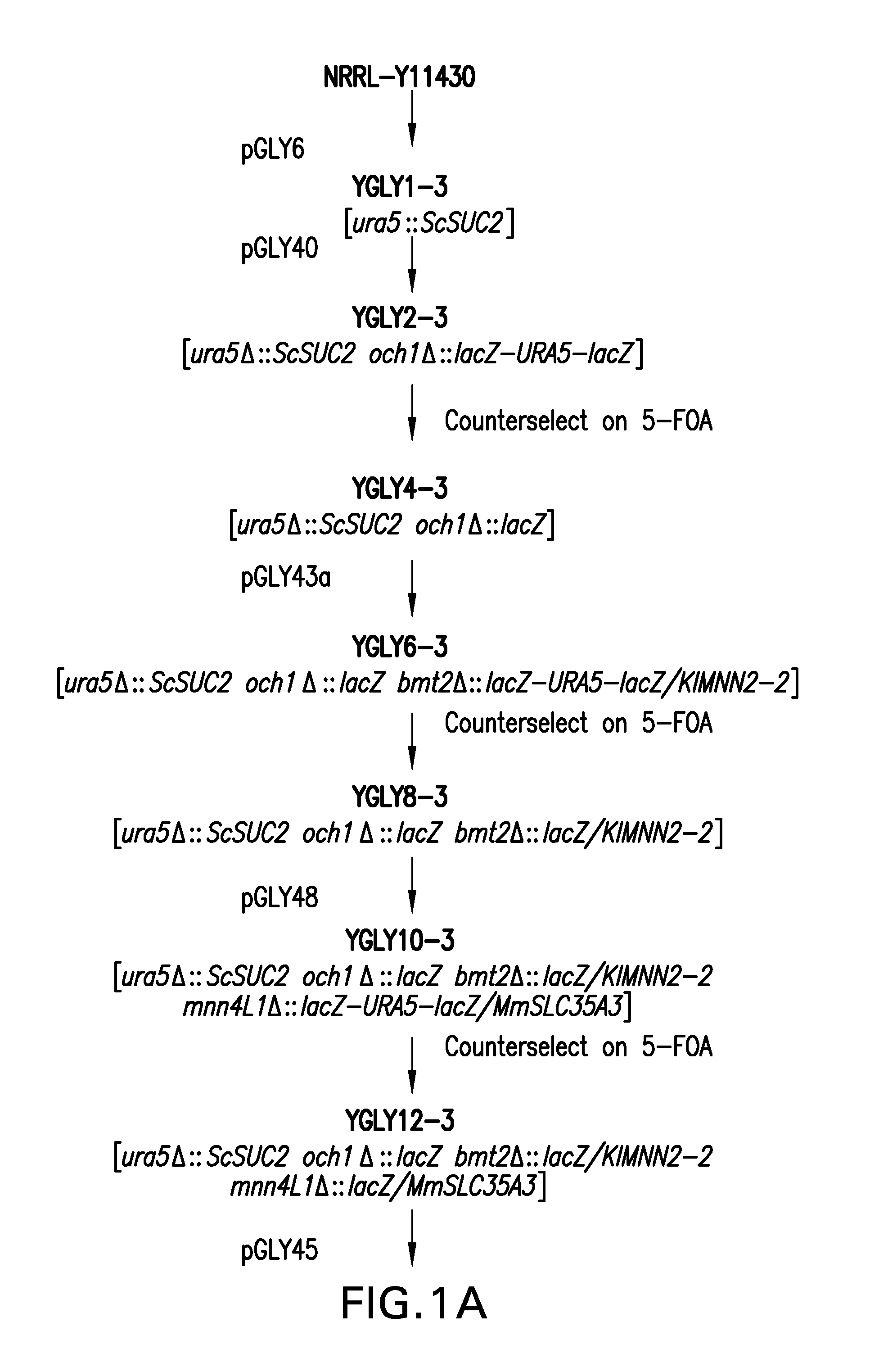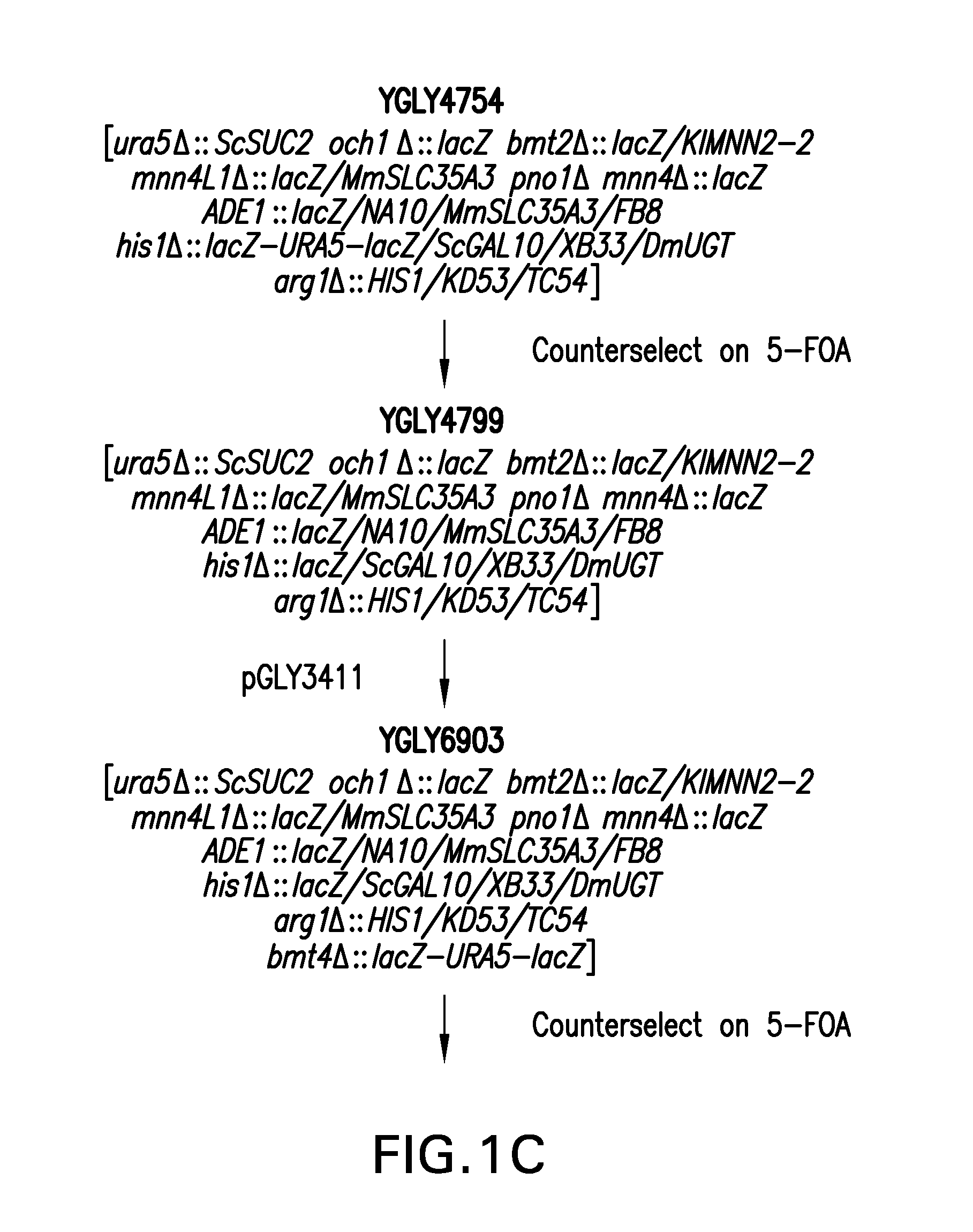Method for increasing n-glycosylation site occupancy on therapeutic glycoproteins produced in pichia pastoris
- Summary
- Abstract
- Description
- Claims
- Application Information
AI Technical Summary
Benefits of technology
Problems solved by technology
Method used
Image
Examples
Example
[0219]As shown in Example 3, the N-glycosylation composition of antibodies produced in Pichia pastoris strains, which have been genetically engineered to make galactose-terminated N-glycans, appear to range from about 50-60 mole % G0, 18-24 mole % G1, 3-8% mole % G2, 12-17 mole % Man5, and 3-6 mole % hybrids.
[0220]Therefore, provided is a glycoprotein composition comprising a plurality of antibodies wherein at least 70% of the antibody molecules in the composition have both N-glycosylation sites occupied and about 50-70 mole % of the N-glycans have a G0 structure, 15-25 mole % of the N-glycans have a G1 structure, 4-12 mole % of the N-glycans have a G2 structure, 5-17 mole % of the N-glycans have a Man5 structure, and 5-15 mole % of the N-glycans have a hybrid structure, and a pharmaceutically acceptable carrier. Further still is provided is a glycoprotein composition comprising a plurality of antibodies wherein at least 70% of the antibody molecules in the composition have both N-g...
Example
Example 1
[0231]Plasmids comprising expression cassettes encoding the Leishmania major STT3D (LmSTT3D) open reading frame (ORF) operably linked to an inducible or constitutive promoter were constructed as follows.
[0232]The open reading frame encoding the LmSTT3D (SEQ ID NO:12) was codon-optimized for optimal expression in P. pastoris and synthesized by GeneArt AG, Brandenburg, Germany. The codon-optimized nucleic acid molecule encoding the LmSTT3D was designated pGLY6287 and has the nucleotide sequence shown in SEQ ID NO:11.
[0233]Plasmid pGLY6301 (FIG. 2) is a roll-in integration plasmid that targets the URA6 locus in P. pastoris. The expression cassette encoding the LmSTT3D comprises a nucleic acid molecule encoding the LmSTT3D ORF codon-optimized for effective expression in P. pastoris operably linked at the 5′ end to a nucleic acid molecule that has the inducible P. pastoris AOX1 promoter sequence (SEQ ID NO:23) and at the 3′ end to a nucleic acid molecule that has the S. cerevisi...
Example
Example 2
[0236]Genetically engineered Pichia pastoris strain YGLY13992 is a strain that produces recombinant human anti-Her2 antibodies and Pichia pastoris strain YGLY14401 is a strain that produces recombinant human anti-RSV antibodies. Construction of the strains is illustrated schematically in FIG. 1A-1H. Briefly, the strains were constructed as follows.
[0237]The strain YGLY8316 was constructed from wild-type Pichia pastoris strain NRRL-Y 11430 using methods described earlier (See for example, U.S. Pat. No. 7,449,308; U.S. Pat. No. 7,479,389; U.S. Published Application No. 20090124000; Published PCT Application No. WO2009085135; Nett and Gerngross, Yeast 20:1279 (2003); Choi et al., Proc. Natl. Acad. Sci. USA 100:5022 (2003); Hamilton et al., Science 301:1244 (2003)). All plasmids were made in a pUC19 plasmid using standard molecular biology procedures. For nucleotide sequences that were optimized for expression in P. pastoris, the native nucleotide sequences were analyzed by the...
PUM
| Property | Measurement | Unit |
|---|---|---|
| Fraction | aaaaa | aaaaa |
| Fraction | aaaaa | aaaaa |
| Fraction | aaaaa | aaaaa |
Abstract
Description
Claims
Application Information
 Login to View More
Login to View More - R&D
- Intellectual Property
- Life Sciences
- Materials
- Tech Scout
- Unparalleled Data Quality
- Higher Quality Content
- 60% Fewer Hallucinations
Browse by: Latest US Patents, China's latest patents, Technical Efficacy Thesaurus, Application Domain, Technology Topic, Popular Technical Reports.
© 2025 PatSnap. All rights reserved.Legal|Privacy policy|Modern Slavery Act Transparency Statement|Sitemap|About US| Contact US: help@patsnap.com



